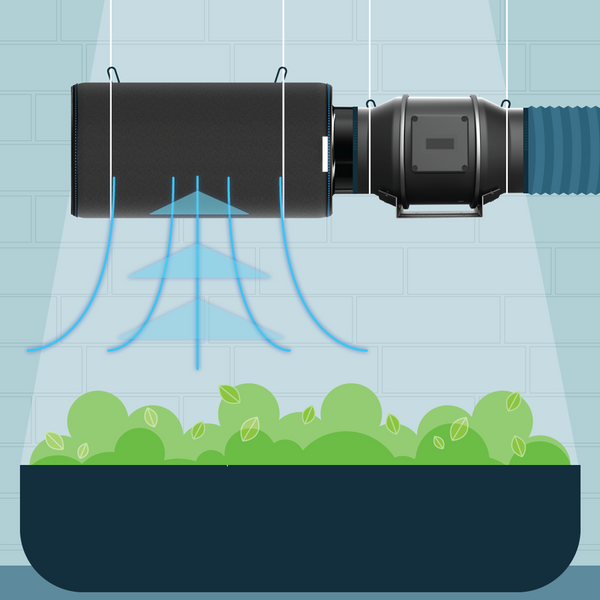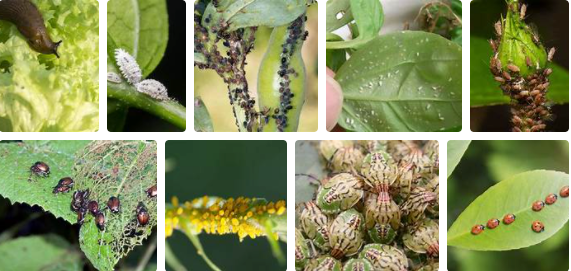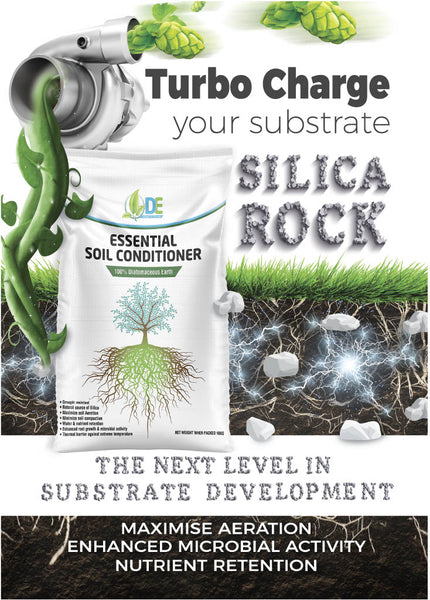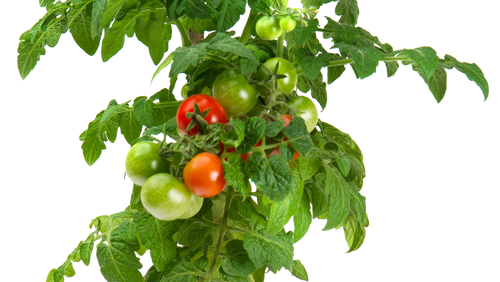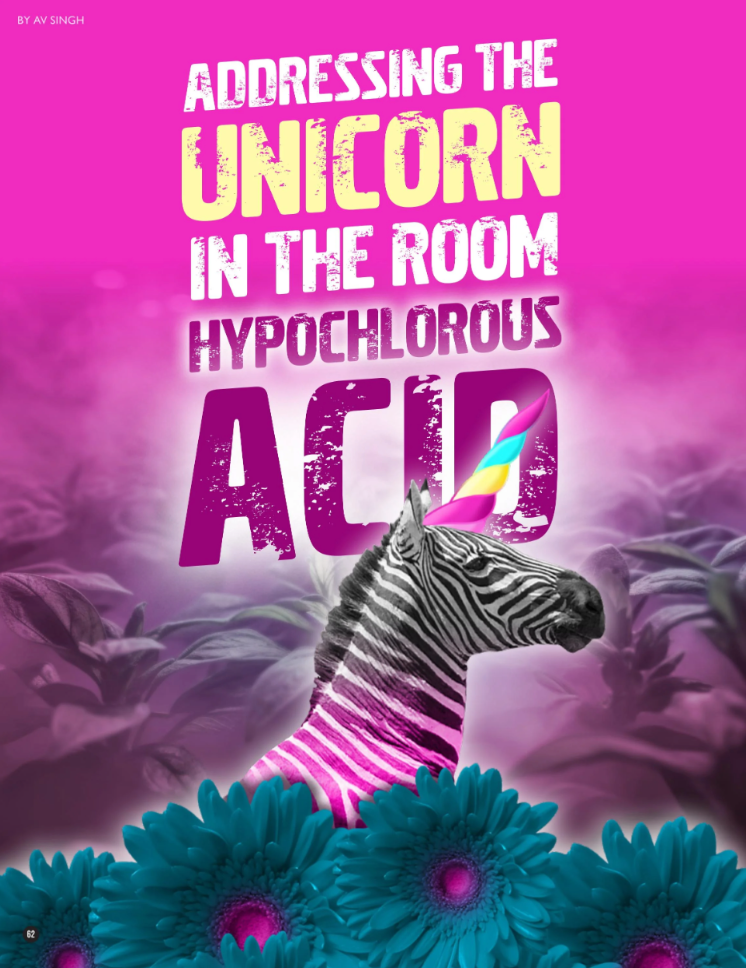
Adressing the Unicorn in the Room: Hypochlorous Acid
Unequivocally, the best kept secret that many people have been shouting about for over 190 years is hypochlorous acid (HOCI), commonly referred to as “Electric Water”, HOCI is an aqueos solution with concentrations that range from 1000 ppm to as low as 1 ppm and ideally has a near neutral pH. This simple compound that includes hydrogen, oxygen and chloride can address everything from powdery mildew and smelly shoes to SARS-CoV-2, acne, the eggs of spider mites and even bad breath!
Not all hypochlorous acids are created equally...
HOCI has never been registered as a pesticide or a fungicide; instead, widespread testimonials have witnessed its efficacy in many pests and pathogens, plant health and vigor. More likely, HOCI is commonly registered as a disinfectant. The “magic” behind this unicorn transcends agriculture and is routinely used in hospital sanitation, wound irrigation, cosmetics and the industrial cleaning of commercial spaces.
More Stability:
Despite HOCI being discovered in 1834 and recognised as one of the most potent and safest disinfectants, it has yet to receive favour over other products like isopropyl alcohol and bleach due to its lack of stability. In years past, manufactured HOCI generated from the electrolysis of water containing either non-iodised salt (NaCI) or hydrochloric acid (HCI) would quickly revert into its component parts, making it ineffective. Proprietary technologies have now created HOCI solutions at various concentrations that can be shelf-stable for over a year. The variability in shelf stability highlights one of the other reasons why HOCI has not garnered widespread acceptance, as not all hypochlorous acids are created equally. People wrongly assume that all HOCI is the same. HOCI in an aqueous solution can have a wide range of pH and purity (i.e., removing much of the NaOH – sodium hydroxide), which can have a bearing on its stability and ability as a disinfectant.
The Rumour Mill:
Misleading information is another major factor that has limited HOCI from being recognised as a disrupter technology. Many have concluded that HOCI in water is no different than a sodium hypochlorite (NaCIO) solution, a common bleaching agent. They do not consider that bleach contains harmful chloramines and stabilisers such as sulphates and phosphates that promote algal blooms. Stable HOCI remains as HOCI, while in contrast, NaCIO will dissociate into having hypochlorite (CIO-) ions which can be very corrosive to humans and metals. Interestingly, many argue that the disinfectant efficacy of bleach comes from the presence of HOCI. The electrical neurality of HOCI, especially when designed to have a near-neutral pH, can penetrate plant cell walls and enter cell membranes to exert bactericidal effects on pathogens while causing little or no harm to plants and humans.
All Mammals Produce It:
When we consider using chemicals as disinfectants or pesticides, we tend to think of these created by people wearing white lab coats and appropriate PPE (Personal Protective Equipment). Ironically, HOCI is something all mammals produce as a first line of defense against pathogens. White blood cells (neutrophils) chase down invading pathogens, releasing chemicals like the most powerful oxidising agent – HOCI. HOCI produced in our bodies remains stable for seconds but can kill bacteria, fungi, viruses and perhaps even viroids in plants.
Even more exciting about all mammals producing HOCI is that in appropriate concentrations, many of the beneficial microbes we find on our skin, mouths and gut microbiome are not impacted by HOCI. Many beneficial microbes are the same as those found in and on our plant leaves and soil. For example, gram-positive endospore-forming beneficial bacteria like bacillus subtilis are not killed by HOCI when using recommended rates and contact time. This suggests that growers and gardeners seeking the benefits of microbes associated with nutrient cycling and plant protection can use HOCI in moderation.
HOCI in the Garden:
The Myriad uses for HOCI in other sectors, such as personal, health and dental care, are ever-increasing. However, agriculture is the focus of this article, and I am sharing information gained through personal experimentation, anecdotal observations and communication with other growers. Although not a paid advertorial, my comments are based on five Canadian HOCI products registered as disinfectants, foliar fertilisers, fruit and vegetable washes, or cleaners and descalers.
Most adopters of HOCI are initiated by using it in their sanitation programme, but it’s not an easy entrance. For many growers, the notion that “something non-toxic is going to disinfect better than something toxic” is hard to swallow.

However, the efficacy, albeit vastly superior to alcohol, quaternary ammonium, bleach, or hydrogen peroxide, is not the only factor in their decision. The safety of their workers plays a significant role in choosing HOCI. In contrast, with products like alcohol and bleach, HOCI requires no PPE and leaves no residue or odour. The contact time for most pathogens is relatively short, so using a fogger or mister works well. There is no safety issue as one might have with an electrostatic sprayer and isopropyl alcohol.
Moreover, several scientific papers claim HOCI does not appear to cause pathogens to mutate, like bleach, alcohol, or hydrogen peroxide. This may lead growers to use HOCI to help slow the mutation of plant pathogens. Within the realm of sanitation, HOCI is more readily accepted as an irrigation and filter cleaner, removing biofilm and scale deposits. Many hydroponic, aeroponic, and deep-water culture systems titrate low concentrations that keep fertigation lines clean and provide root protection, allowing for healthy roots.
HOCI on Seeds and Cuttings:
The less chartered waters for HOCI and frankly more interesting than surface sanitation, is what growers and gardeners worldwide have been experimenting with by using HOCI on plants. For some growers, HOCI starts with the seed or the cutting (clone.) Low concentrations as a seed soak help reduce pathogens that may have established, like fusarium or botrytis, while having minimal impact on the beneficial seed microbiome. Similarly, in clones, HOCI helps oxidise the wound from the cutting action and reduces the probability of infection. It is important to note that chloride is also an essential element that can help drive good vegetative growth.
Exciting Rewards:
Perhaps an expanded interpretation of the fruit and vegetable wash label or using HOCI as a foliar fertiliser, several growers use HOCI as a prophylactic mist throughout the growing cycle and are reaping some exciting rewards. Expectedly, diseases like powdery mildew and botrytis are non-existent, but many growers have noticed fewer pests like aphids, thrips, fungus gnats and spider mites. Most interestingly, testimonials stating shorter growing cycles and increased flavour and aromas (terpenes) have been commonly reported. Mushroom growers mist cultivation rooms, growing media and mature fruiting bodies to establish a sterile environment and prolong shelf-life.
Magical Solutions:
As a non-mainstream agronomist, you get accustomed to being presented with some truly “magical” solutions that would be game changers, only to be frustrated by people unwilling to try an alternative but still complain about the dysfunctional status quo. Hypochlorous acid, when generated at pH neutral, is that magical unicorn that shows promise to revolutionise disinfection and, to some extent, cultivation practices, safeguarding crops and consumers alike.
Written by Av Singh, PhD

